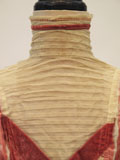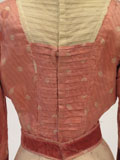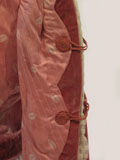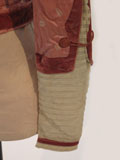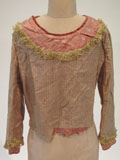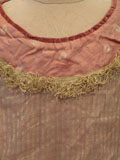Overview
This bodice is an excellent example of the Edwardian era (1907-1912). Its high collar, elevated and exaggerated bust, slim sleeves, and narrow belted waist exemplify the shift from the early 1900s pouter pigeon silhouette to the tubular silhouette popular before and during World War I. It is made from a printed silk jacquard that has been flat-lined to muslin. There are insets of pleated cotton bobbinette flat-lined to soft silk organza, and an overlay of handmade bobbin lace. The bodice is trimmed with velvet bands and soutache rolled into fake frogs ornamenting the sleeves.
One of the most interesting aspects of this bodice is its unfinished state; it appears to have begun as a dress and was in the process of being altered as a separate bodice and skirt with new style lines but the alteration was never completed. It was common practice throughout this time, since fashion changed so rapidly, to take a garment fitting the previous trend and alter it to fit the new one. This bodice shows obvious signs of wear which means that it is not new. It has exposed raw edges along the center panels in the front and back as well as at the waist. One could surmise that the owner had this bodice made during the early part of the century when full, blouson bodices were popular and had begun the process of taking in the excess fullness to achieve the slimmer silhouette of Edwardian era.
Figure 1: Bodice Front |
Figure 2: Bodice Back |
 |
 |
Bodice Details - Exterior
The bodice has a severely tapered silhouette, as seen in Figure #1 above. The ample bust, narrowing to the belted waist is emphasized by the V-shape created by the velvet bands. Norah Waugh notes that same transition of style in her book, Corsets and Crinolines stating on page 87: "1904-1905 were the peak years of the "S" curve; from then on the line began slowly to straighten out, though it was not until 1907, when the dresses themselves began to lose their fullness, that the new fashion line, long and svelte, really began to take shape."
The bodice is constructed from 17 pattern pieces, not including the different widths of velvet ribbon.
The bobbinette in the front and back was pleated before the fabric was cut following the pattern using a 1/4" pleat with 1/4" returns and spaces. This is mimicked on the back of the bodice with the pink silk for the lower panels. As can be seen in Figures #6 and #7 below, where the seams are exposed the hand-crafted lace does not extend to the edge of the silk seam allowance. This indicates that the wearer would have most likely continued the use of wide velvet bands to cover the exposed areas, going from the front and over the shoulder to cover the exposed seams in the back. The velvet bands that create a V in the front are 1" wide.
The collar stands at 2 1/2" center front and 3" center back. Instead of changing the pleat ratio to adjust to these dimensions, the collar was cut as a rectangle and the top edge was cut at an angle making the front is shorter than the back. The edge was then covered with a piece of soutache and a small detail of finely pleated net and twisted white and pink cords were added at the neck edge.
The sleeves are pieced together to make it appear that there is an over and under sleeve but in reality the pieces create a simple, unshaped sleeve with an under arm seam. Detail is added with the velvet bands under the scalloped edges. These edges are ornamented with spirals made of soutache, as can be seen in Figure #3 below. The spirals are 4" apart and have two 3 1/4" wide connectors that cross over the pleated bobbinette. At its most visible the velvet band is 1 1/2" wide and at its least it is 3/4" wide.
Figure 3: Sleeve Spirals and Scalloped Edge |
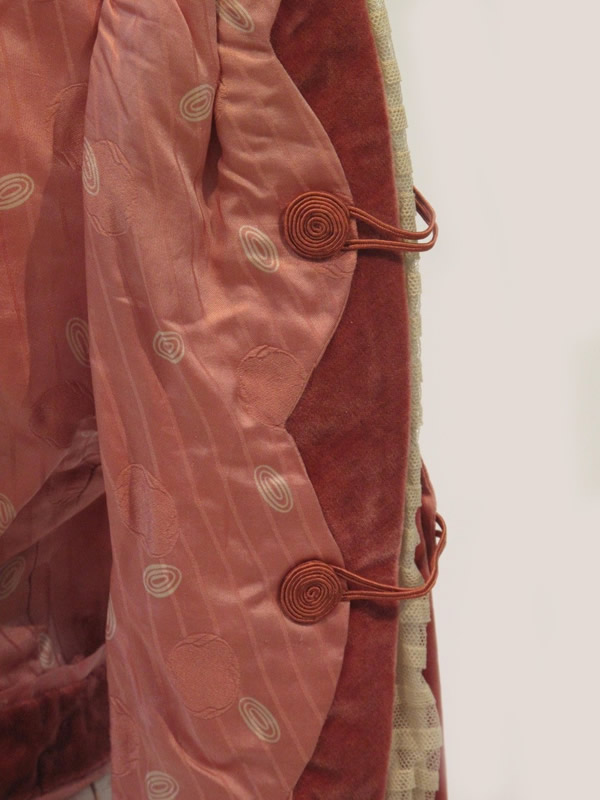 |
Bodice Details - Interior
The bodice opens at center back, as can be seen in Figure 2 above. 13 hooks and bars are spaced 1 1/4" apart to close with a 1/2" overlap. It is 18" from the top of the collar to the raw edge at the bottom of the bodice. On the inside of the left center back bodice opening there is a covered 1/8" wide bone that extends from the top of the collar to the bottom of the pleated bobbinette which is 8 1/2" inches long.
The collar is lined with soft silk organza which helps hide the interior structure since it is supported by three bones in addition to the one at center back. On either side seam there is a 1/8" wide bone covered with a ribbon that goes from the top edge of the collar to the armscye, 8 1/2" down. The last bone at center front seems to be made of plastic and is 1/2" wide and only 2" long.
In addition to the collar, the front and back pleated bobbinette sections of the bodice are lined with soft silk organza as are the pleated bobbinette sleeves. The pink silk jacquard is lined with unbleached muslin that is speckled with fine brown dots.
Most of the interior seams in this bodice have been completed with French seams, as can be seen in Figure #4 below. Where the silk meets the pleated bobbinette, the seam allowance is turned under and whip-stitched by hand. This hand-work contrasts the rest of the bodice because almost all of the stitching on the interior and exterior bodice was done by machine.
An egg, see Figure #5 below, has been added to each bodice armscye to fill out the gap created by wearing a corset to achieve a smooth line. It is 3 1/2" long and 5" wide with the bottom corner positioned at the side seam. The light padding is held in place with a small running stitch over which the egg was whip-stitched to the bodice lining.
Although the design is simple, the pattern for the lining is different from the exterior which was constructed from 17 pattern pieces. The center front is cut on the fold; it appears asymmetrical because of the velvet bands.
Figure 4: Bodice Interior |
Figure 5: Armscye |
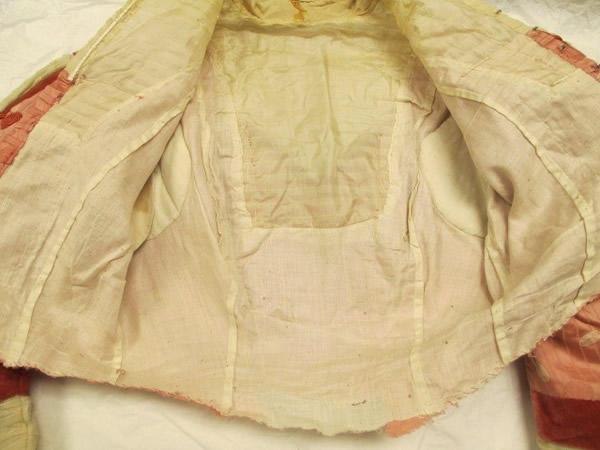 |
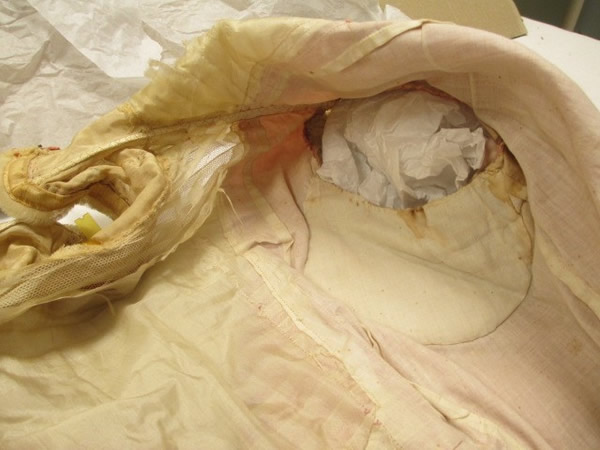 |
Damage
Although the bodice has sustained some damage over the years it is mainly confined to the interior, except for the changes made by the alteration process. The under arms are discolored from sweat and much of the soft silk organza is deteriorating. The muslin used for the flat-lining is still in good condition. The bones are warped and the one at center front has snapped in half. The damage to the exterior is limited to deterioration of the pleated net around the collar which tearing away from the seam and some discoloration under the arms.
Figures #6 and #7 below show the exposed seam allowances on the front of the bodice, resulting from the incomplete alteration.
Figure 6: Exposed Seamson the left side |
Figure 7: Exposed SeamsOn the right side |
 |
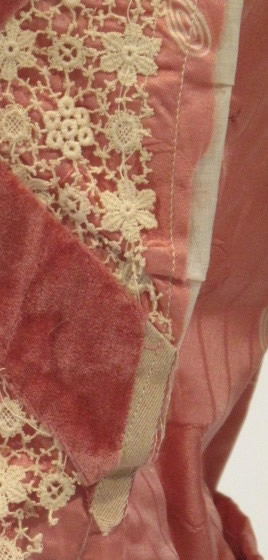 |
© Corinne Anneliese Hodges Doss, 2016




